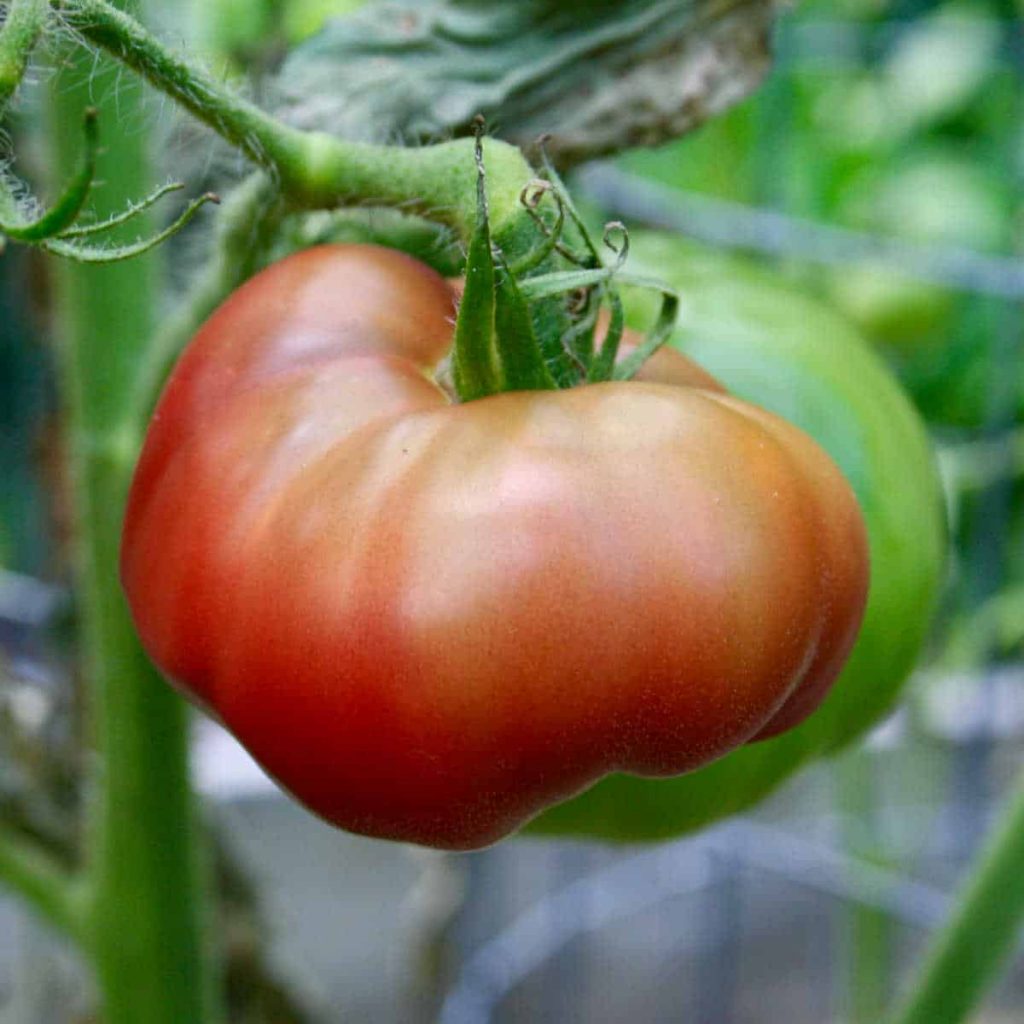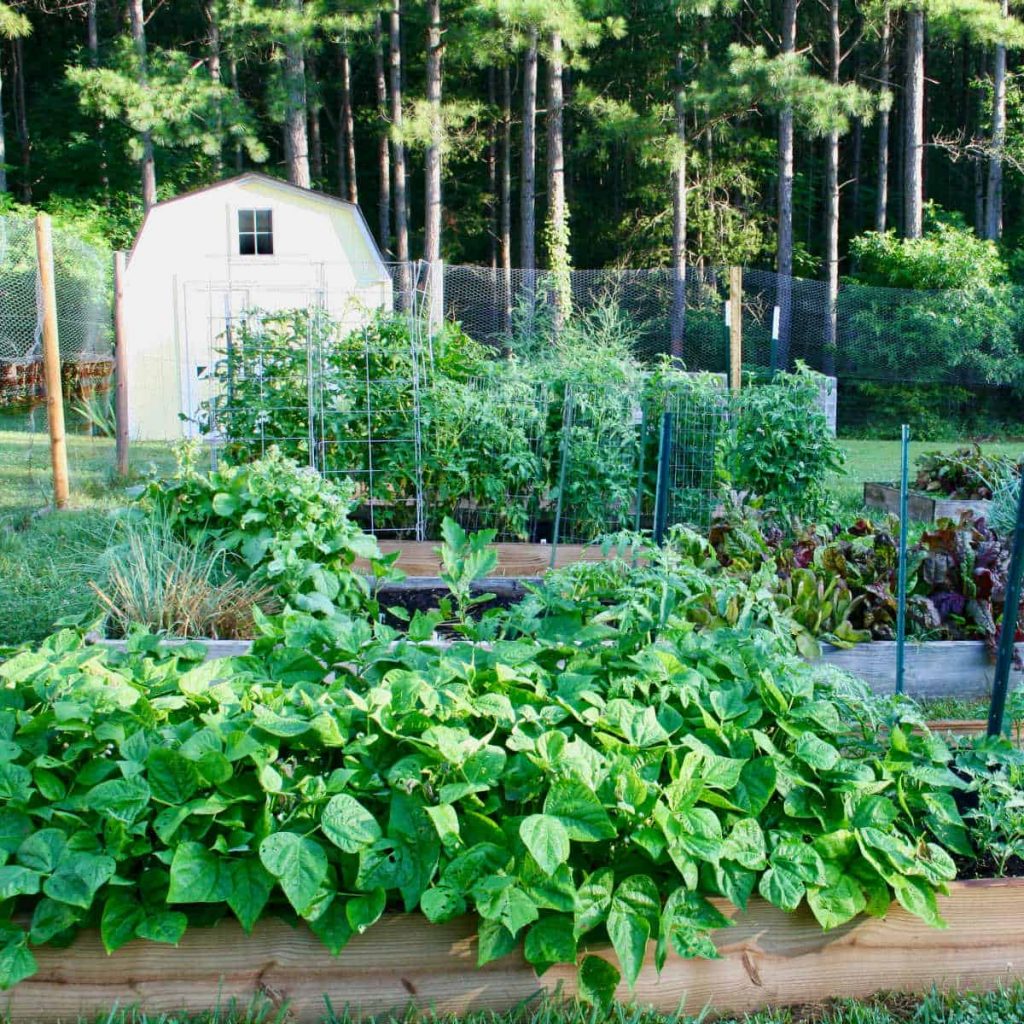If you are looking for information on how to start a vegetable garden from scratch or starting a new vegetable garden , you may find yourself lost in a sea of advice. I’ll make it easy for your start a backyard vegetable garden by breaking down the steps into four simple categories: Location, Soil, Size, Timing.
Table of contents
Where Should You Plant Your Vegetables?
Look for the sunniest spot in your yard. I don’t care if it’s your front yard, side yard, or backyard, but find a spot that gets the best light. Most vegetable plants need six hours or more of bright, direct sunlight.
Yes, you can grow some vegetables like green beans in partial shade, but sunlight is absolutely needed for vegetables like tomatoes and peppers. If you don’t have bright sunlight in your backyard, consider planting tomatoes in pots on the deck (if the deck is the sunniest spot) or even using your front yard. Unless your Homeowners Association or town has a rule against digging up your lawn and planting a vegetable garden, why not turn your front lawn into a vegetable garden?
What Kind of Soil Do I Need and What Do I Add to My Soil?
Soil is more than the backyard dirt under the grass. It’s a complex structure containing minerals, organic material, water, air, and lots of microscopic critters that keep your plants healthy. When you’re starting a backyard vegetable garden, dig up the grass and till the soil under it to a depth of about a foot. Add compost or bags of cow manure if you don’t have a compost pile yet.
How Big Should a Backyard Vegetable Garden Be?
A good starting size for a family backyard vegetable garden is 10 feet x 10 feet. That’s plenty of room for tomatoes, peppers, lettuce, and other family favorites.
This chart will help you figure out how many plants you need of each vegetable. It tells you how much space each plant requires. A 10 x 10 foot backyard vegetable garden provides 100 square feet of gardening space (10 x 10).
| Vegetable Plant | Space Between Plants | Space Between Rows |
| Bush beans | 2 – 4 inches | 18 – 24 inches |
| Beets | 3 – 4 inches | 12 – 18 inches |
| Carrots | 1- 2 inches | 12 – 18 inches |
| Cucumber (trellis) | 2 – 3 inches | 30 inches |
| Lettuce | 1 – 3 inches | 1 – 3 inches |
| Peppers | 14 – 18 inches | 18 – 24 inches |
| Tomatoes | 24 – 48 inches | 48 – 60 inches |
| Zucchini | 24 – 36 inches | 36 – 48 inches |
Timing – When to Plant Vegetables
When should you plant your vegetable garden?
The answer in the United States depends on what gardening zone you live in. Gardening zones, also called USDA hardiness zones, offer a consistent way for backyard gardeners to judge when it is safe to plant tender vegetables and annual flowers.
The USDA hardiness map is based on the average last frost date in the spring and the average first frost date in the fall. Note that these dates are average; an average is made from adding up all of the dates and dividing it by the number of dates. A frost can still occur before or after the hardiness zone date, but the averages will help you figure out when you can plant such tender vegetables as tomato plants, peppers, eggplants, and so on.
You can view the USDA Hardiness Zone map here: Master Gardeners of Northern Virginia
Starting a Vegetable Garden from Scratch
What Should You Grow?
What Do You Like to Eat?
The first step to choosing vegetables to grow in your first vegetable garden is to choose those which you and your family like to eat. It doesn’t make sense to grow twenty tomato plants if only you eat tomatoes or growing beets if your family hates them.
Make a list now of the vegetables and fruits you and your family enjoy.
What Is Economical to Grow?
Next, take a close look at the list you’ve made. Some of the fruits and vegetables on the list are probably less expensive and equally nutritious to buy at the store then to grow in your backyard.
A good example of this is the potato. Potatoes grow easily throughout the temperate gardening zones, but they are often troubled by things like the Colorado potato beetle (my particular nemesis here in Virginia).
I can grow potatoes, but should I grow them? This year, I’ve chosen not to. Instead, I’ve planted my large potato beds with a mixture of French melons, sweet potatoes, storage beans like Jacob’s Cattle, acorn squash, and sunflowers.
It’s not that I can’t grow potatoes – it’s just that my potatoes, although delicious, weren’t as large as those we can buy from Idaho. The thin-skinned Yukon gold potatoes grew well in my Virginia garden but the large brown Russets that make the best baked potatoes just don’t get to the same size here as they do in other parts of the country.
Potatoes ship well, taste fine from storage, and are less expensive for me to buy at the grocery store then to grow, and always in season. Hence, it makes more sense for my to buy them then to grow them.

What Tastes Better Home Grown?
Some vegetables just taste better when grown in your backyard. Tomatoes are a great vegetable to grow for first time gardeners (if you like them, that is!)
I love heirloom tomatoes, oddly colored tomatoes (yellow, “black”, purple). I love making meals with tomatoes, salads, fresh tomato juice, canning my own tomato juice, you name it!
The tomatoes available at the local supermarket are dreadful. They taste like cardboard and never seem to ripen. Why? The variety grown commercially for supermarket shipment is thicker walled to withstand the bumps and shocks of shipping. But to get a thicker skin, you lose flavor.
I could wait and buy my tomatoes at the farmer’s market, and if my crop fails, that’s what I will do. But in the meantime, plants are inexpensive, grow well, and taste fantastic. Tomatoes, then may be a great choice for your first vegetable garden if you love them as much as I do!
You can grow tomatoes from seeds or purchase plants. The choices is yours. I grow ours from seed so we have the right number of Roma tomatoes to make juice and tomato sauce from scratch.
How Much Space Do You Have?
Lastly, there’s the issue of space. Few gardeners have the luxury of large, open spaces. Most grow their first vegetable garden in pots or containers in the backyard or on an apartment balcony or deck.
Plants such as tomatoes grow vertically Vertical Gardening to Expand Your Space(upwards) and require a 1-gallon container. You can grow a lot of tomatoes from one plant and they taste great. It makes sense to grow them when your space is limited for your first vegetable garden.
Corn grows vertically (tall) rather than takes up space, but it requires a lot of sunlight, fertilizer, and water, so you might not want to use what space you have to grow it at home if you have access to fresh corn in the summer.
Other plants, such as watermelons and pumpkins, produce long, trailing vines. The vines can be up to 20 feet or more! They are not for small spaces. These may be better purchased then grown if space limitations are a concern.
Garden Spacing: Container Gardening
Many people feel that they lack enough space to start a vegetable garden. Or, perhaps they don’t want to give up their backyards – they want to keep a lawn area for their children or pets to play.
An easy alternative is to grow vegetables in pots or containers. Many vegetables, such as leafy greens, tomatoes, peppers, and even fruit such as strawberries are great container garden plants.
If you have sunshine but not a lot of space, growing vegetables in pots or containers may be a great alternative.

More Resources to Help You Grow Your First Vegetable Garden
In addition to the many books available at your local public library and online resources, if you are in the United States, your local Cooperative Extension Office offers an amazing set of resources.
The Cooperative Extension system is based within land-grant universities in every state. They offer online publications, free local workshops, low-cost soil testing and much, much more.
They are also a great place to talk to Master Gardeners. Master Gardeners are volunteers who have completed 100 hours of education plus 20 or more hours of continuing education and volunteer service per calendar year in the field of horticulture. I’m a certified Virginia Master Gardener volunteer; there are thousands nationwide, each of us with an area of specialty, educators who offer advice and scientific information to grow your first vegetable garden and more.
Looking to Grow a Container Vegetable Garden?
Raised Bed Vegetable Gardening





I live in ventral Fla just put up 10×20 greenhouse I mostly grow ornamental or carnivorous plants bot I would like to grow yellow squash in pots I hope I can. I have grown tomatoes and green onions no problem. With the green house can I start the squash now.
Hi Debbie, you should be able to grow squash at the same time as you grow tomatoes. Squash are insect pollinated so you may need to let the bees in for a bit or use a paintbrush or swab to move pollen from male to female flowers. Good luck, let me know how it turns out.